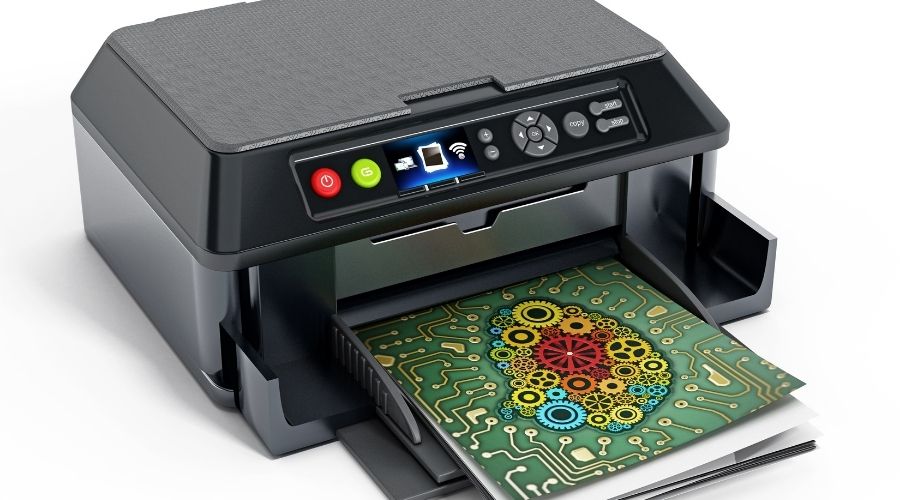In the dynamic print industry, establishing a strong brand identity is crucial for printers looking to stand out, attract clients, and drive business growth. This comprehensive guide explores effective strategies for crafting a distinctive brand that resonates with your target audience and positions your printing services for long-term success.
From understanding the current market landscape to developing a visually appealing and emotionally compelling brand personality, this article provides a roadmap for printers seeking to elevate their brand and differentiate themselves in a competitive marketplace.
Key Takeaways on Building Brand Identity for Printers
- Gain insights into the evolving print industry and its unique branding challenges
- Discover the core foundations for building a strong printer brand identity
- Learn how to develop a distinctive brand personality that connects with your audience
- Explore strategies for creating a visually striking and cohesive brand identity system
- Understand the importance of digital presence and online brand management for printers
- Discover effective marketing tactics to promote your printer brand and drive business growth
- Learn how to measure and optimize your brand’s performance for maximum return on investment

Understanding the Print Industry Brand Landscape
In the dynamic world of print services, printers must navigate a competitive landscape that demands strategic print industry branding and printer brand positioning to stand out. This section delves into the current market trends, competitive analysis frameworks, and unique challenges facing print service providers as they strive to build strong, recognizable brands.
Current Market Trends in Print Services
The print industry has undergone a significant transformation in recent years, with emerging technologies and shifting consumer preferences shaping the competitive landscape. Key trends include:
- The rise of digital printing and its impact on traditional offset printing
- Increasing demand for personalized and customized print products
- Growing importance of sustainability and eco-friendly print solutions
- The integration of print services with digital marketing and omnichannel strategies
Competitive Analysis Framework
To effectively position their printer brand, service providers must understand the competitive dynamics within the industry. A comprehensive competitive analysis should consider factors such as:
- Market share and pricing strategies of key players
- Unique product or service offerings that differentiate competitors
- Strengths, weaknesses, and areas of innovation across the industry
- Emerging trends and disruptive technologies that can impact the competitive landscape
Industry-Specific Challenges
The print industry faces a unique set of challenges that can impact a printer’s branding efforts. These include:
| Challenge | Description |
|---|---|
| Commoditization | The perception of print products as a commodity, leading to increased price competition |
| Technological Advancements | The need to invest in and adapt to new printing technologies to remain competitive |
| Changing Customer Demands | Shifting customer preferences for personalized, on-demand, and sustainable print solutions |
By understanding these industry trends, competitive factors, and unique challenges, printers can develop strategic print industry branding and printer brand positioning initiatives to differentiate themselves and build strong, recognizable brands in the market.
Building Brand Identity for Printers: Core Foundations
In the dynamic world of the print industry, crafting a strong brand identity is crucial for printers seeking to stand out and connect with their target audience. The core foundations of building a printer’s brand identity lie in establishing a clear purpose, defining core values, and positioning the business uniquely in the market.
Defining Brand Purpose
The starting point for any successful printer’s brand identity is a well-defined brand purpose. This encompasses the reason for the business’s existence, its overarching mission, and the value it aims to deliver to customers. By articulating a compelling brand purpose, printers can create a solid foundation for their brand and guide all subsequent branding decisions.
Establishing Core Values
Alongside a clear brand purpose, printers must also identify and cultivate their core values. These values represent the principles, beliefs, and behaviors that guide the organization and shape its culture. Aligning the business’s operations and customer interactions with these core values helps to build trust, authenticity, and a strong emotional connection with the brand.
Positioning the Printer’s Brand
To differentiate themselves in the crowded print services market, printers must develop a unique and compelling brand positioning. This involves clearly defining the brand’s target audience, identifying its key competitive advantages, and communicating a distinct value proposition. By positioning the brand effectively, printers can carve out a distinctive niche and appeal to their ideal customers.
| Key Elements of Printer’s Brand Identity | Description |
|---|---|
| Brand Purpose | The overarching reason for the printer’s existence and the value it aims to deliver |
| Core Values | The principles, beliefs, and behaviors that guide the printer’s operations and culture |
| Brand Positioning | The unique market niche and value proposition that sets the printer apart from competitors |
By establishing these core foundations, printers can build a cohesive and impactful brand identity that resonates with their target audience and positions them for long-term success in the highly competitive print services market.
Developing Your Printer’s Brand Personality
In the fiercely competitive print industry, crafting a distinct brand personality is crucial for printers seeking to stand out from the crowd. By cultivating a unique voice, embodying core values, and forging emotional connections with customers, printing businesses can establish a lasting impression and foster brand loyalty.
Voice and Tone Guidelines
Establishing clear guidelines for your printer’s brand voice and tone is the first step in shaping its personality. Whether your brand exudes professionalism, creativity, or personability, maintaining a consistent tone across all touchpoints – from website copy to customer interactions – will ensure a cohesive and memorable brand experience.
Brand Values and Mission Statement
Articulating your printer’s core values and mission statement is a powerful way to imbue your brand with a sense of purpose and authenticity. By aligning your business practices and customer interactions with a well-defined set of values, you can foster a deeper emotional connection with your target audience and differentiate your brand from the competition.
Emotional Connection Points
- Identify your printer’s unique selling points and how they resonate with customer needs and aspirations.
- Craft compelling brand narratives that evoke positive emotions and showcase your commitment to quality, innovation, or customer service.
- Leverage the power of visual storytelling, such as imagery and video, to create a distinct and memorable brand identity that resonates with your target market.
By thoughtfully crafting your printer’s brand personality, you can cultivate a strong emotional connection with your customers, positioning your business as a trusted and reliable partner in the dynamic print industry.
Creating a Distinctive Visual Identity System
In the dynamic print industry, a compelling printer visual identity is the cornerstone of your brand’s success. Crafting a distinctive visual identity not only sets you apart from competitors but also fosters a lasting emotional connection with your target audience. From captivating logo designs to vibrant color palettes, every element of your print branding campaigns must work together to create a cohesive and memorable brand presence.
At the heart of your visual identity lies your logo. This symbolic representation should be a perfect fusion of visual elegance and conceptual depth, reflecting the essence of your printing business. Meticulously selecting the right typography, color scheme, and graphic elements can transform a simple logo into a powerful brand asset that resonates with your audience.
Beyond the logo, a comprehensive visual identity system encompasses a range of design elements, including:
- Consistent color palette that evokes your brand’s personality
- Versatile typography that enhances readability and brand recognition
- Distinctive imagery, illustrations, and graphic patterns that reinforce your brand’s unique identity
- Cohesive stationery, marketing materials, and digital assets that seamlessly integrate your visual branding
By carefully curating these visual elements, you can create a distinct brand aesthetic that captivates your audience and leaves a lasting impression. A well-designed visual identity not only elevates the professionalism of your printing business but also fosters trust and credibility with your clients.
Investing in a strategic and visually appealing printer visual identity is a surefire way to differentiate your printing services in the crowded market. Crafting a cohesive and memorable brand presence through print branding campaigns can ultimately drive customer engagement, loyalty, and long-term business growth.
Print Company Brand Positioning Strategies
Crafting an effective brand positioning strategy is crucial for print companies seeking to stand out in a crowded marketplace. By carefully segmenting their target audience, developing a unique value proposition, and employing strategic differentiation tactics, print service providers can establish a strong, lasting brand identity that resonates with their customers.
Target Audience Segmentation
The first step in building a successful printer brand positioning strategy is to deeply understand your target audience. Segment your potential customers based on factors such as industry, company size, geographic location, and specific printing needs. This detailed analysis will help you tailor your messaging, products, and services to the unique pain points and preferences of each distinct target group.
Value Proposition Development
With a clear understanding of your target audience, you can craft a compelling printer marketing strategies value proposition that sets your brand apart. Identify the unique benefits you offer, whether it’s superior quality, innovative technology, exceptional customer service, or cost-effectiveness. Communicate these value points in a way that resonates with your target customers and highlights why they should choose your print company over the competition.
Market Differentiation Tactics
- Develop a distinct brand personality that reflects your core values and unique positioning.
- Emphasize your specialized expertise or niche capabilities to position your print company as an industry leader.
- Leverage innovative printing techniques or technologies to differentiate your products and services.
- Provide exceptional customer experiences that foster loyalty and word-of-mouth referrals.
By implementing these printer brand positioning and printer marketing strategies, print companies can carve out a distinctive place in the market and attract their ideal customers. Consistent execution of these tactics will help build a strong, recognizable brand that stands the test of time.
Digital Presence and Online Brand Management
In the dynamic landscape of the print industry, a robust digital presence has become crucial for building brand identity and staying ahead of the curve. As printing businesses navigate the ever-evolving digital landscape, crafting a strategic online brand management approach is essential for building brand identity for printers and solidifying their position in the print industry branding.
Elevating Your Website
A visually appealing and user-friendly website serves as the digital cornerstone of your printing business. Ensure that your website reflects your brand personality, showcases your services, and provides a seamless customer experience. Incorporate responsive design, clear navigation, and compelling content to engage your audience and drive conversions.
Social Media Mastery
Leverage the power of social media platforms to amplify your brand’s voice and foster meaningful connections with your target audience. Develop a consistent social media strategy that aligns with your brand’s persona, posting engaging content that educates, entertains, and inspires your followers.
Online Reputation Management
Monitor your online presence, respond promptly to customer reviews and feedback, and address any emerging issues. Proactively manage your reputation by curating positive content, addressing concerns, and showcasing the exceptional service and quality your printing business provides.
| Digital Presence Elements | Key Considerations |
|---|---|
| Website Design | Responsive, user-friendly, brand-aligned |
| Social Media Platforms | Strategic content, audience engagement, reputation management |
| Online Reviews and Feedback | Timely response, issue resolution, positive reputation building |
By embracing these digital best practices, printing businesses can effectively build brand identity for printers and solidify their presence in the print industry branding landscape, ultimately driving growth and success in the digital age.

Brand Guidelines for Print Service Providers
Establishing comprehensive printer brand guidelines is crucial for print service providers seeking to maintain a cohesive and consistent visual identity. These guidelines serve as the foundation for ensuring the effective application of the brand across all touchpoints, from marketing materials to product packaging.
Visual Standards Documentation
The first step in developing brand guidelines for printers is to create a detailed visual standards documentation. This comprehensive manual outlines the specific requirements for the brand’s logo, color palette, typography, imagery, and other design elements. By documenting these printer visual identity standards, the brand can be consistently applied across all communication channels, ensuring a harmonious and recognizable brand presence.
Brand Application Examples
- Print collateral: business cards, letterhead, brochures, and marketing materials
- Digital assets: website, social media, email signatures, and digital advertisements
- Product packaging and labeling
- Signage and environmental graphics
- Branded merchandise and promotional items
These brand application examples showcase how the printer brand guidelines can be translated into tangible brand expressions, ensuring a cohesive and professional appearance across all touchpoints.
Quality Control Measures
To maintain the integrity of the brand, print service providers must implement robust quality control measures. This includes the establishment of approval processes, regular brand audits, and the provision of training and resources for employees responsible for brand implementation. By instilling a culture of brand stewardship, print companies can ensure the consistent and high-quality application of their printer visual identity across all interactions with customers and stakeholders.
Marketing Strategies for Printer Businesses
In the competitive print industry, crafting effective printer marketing strategies and implementing dynamic print branding campaigns are essential for printers to stand out and connect with their target audience. By leveraging a diverse array of marketing channels and tailored content, printing businesses can elevate their brand visibility, drive customer engagement, and ultimately, boost their revenue.
One key approach is to embrace the power of digital marketing. This may involve creating a strong online presence through a visually appealing and user-friendly website, actively engaging on social media platforms, and leveraging search engine optimization (SEO) tactics to improve website discoverability. Regularly publishing informative blog posts, videos, and other valuable content can also help position the printer as an industry thought leader and trusted resource.
Direct marketing tactics, such as targeted email campaigns and personalized direct mail pieces, can also be highly effective in reaching potential customers. By segmenting the target audience and crafting personalized messaging, printers can foster deeper connections and showcase their unique value proposition.
Networking and strategic partnerships can also be powerful marketing tools for printing businesses. Collaborating with complementary industry partners, attending trade shows and industry events, and actively engaging with the local community can help expand the printer’s reach and foster valuable relationships.
Ultimately, a well-rounded marketing strategy that combines digital, traditional, and relationship-building tactics can be the key to driving printer marketing strategies and print branding campaigns that resonate with the target audience and propel the printing business towards long-term success.
Measuring Brand Performance and ROI
In the ever-evolving world of printer business identity and print industry branding, it’s crucial to meticulously measure the performance and return on investment (ROI) of your branding efforts. By closely tracking key performance indicators, conducting thorough brand audits, and strategically adjusting your initiatives, you can ensure your printer’s brand remains relevant, impactful, and aligned with your business goals.
Key Performance Indicators
To effectively gauge the success of your printer’s brand, focus on monitoring a comprehensive set of key performance indicators (KPIs). These may include metrics such as brand awareness, customer engagement, website traffic, lead generation, customer retention, and overall market share. By closely analyzing these KPIs, you can identify areas of strength and pinpoint opportunities for improvement.
Brand Audit Processes
Regularly conducting a comprehensive brand audit is essential for understanding the health and positioning of your printer’s brand within the industry. This audit should encompass a thorough analysis of your brand’s visual identity, messaging, digital presence, and customer perceptions. Gather feedback from both internal stakeholders and your target audience to gain a well-rounded perspective on your brand’s performance.
Adjustment Strategies
- Based on the insights gathered from your KPIs and brand audit, develop targeted adjustment strategies to refine and enhance your printer’s brand identity.
- This may involve fine-tuning your visual elements, optimizing your digital platforms, or revising your messaging to better resonate with your target audience.
- Continuously iterate and refine your branding efforts to ensure your printer’s identity remains competitive and adaptable in the ever-changing print industry landscape.
| KPI | Metric | Benchmark | Current Performance |
|---|---|---|---|
| Brand Awareness | Percentage of target audience that recognizes your printer’s brand | 60% | 45% |
| Customer Engagement | Average time spent on your printer’s website | 2 minutes | 1 minute 45 seconds |
| Lead Generation | Number of qualified leads generated per month | 25 leads | 18 leads |
| Customer Retention | Percentage of repeat customers | 75% | 68% |
By consistently monitoring your printer’s brand performance, conducting thorough audits, and implementing strategic adjustments, you can ensure your brand remains a powerful asset that drives growth and success in the competitive print industry.
Conclusion
As you’ve discovered throughout this comprehensive guide, building a strong brand identity is crucial for printers seeking to thrive in the competitive print industry. By understanding the current market trends, analyzing your competitors, and addressing industry-specific challenges, you can lay the foundation for a distinctive and impactful brand.
Crafting your printer’s brand personality, including a well-defined voice, tone, values, and mission, will help you forge an emotional connection with your target audience. Complementing this with a visually striking identity system will further solidify your brand’s position in the market and set you apart from the rest.
Remember, effective brand positioning, a robust digital presence, and strategic marketing tactics are all integral components of building a successful printer’s brand. By continuously measuring your brand’s performance and making data-driven adjustments, you’ll be well on your way to maximizing the return on your branding investments and driving long-term growth for your printing business. print brand personalityFor printing companies looking to measure the success of their branding efforts, it’s essential to establish clear indicators that define what success looks like. These could include metrics such as customer engagement, brand awareness, and a consistent increase in client inquiries. By collecting and analyzing data from various sources, including social media interactions, customer feedback, and market trends, printing companies can better understand how their print brand personality resonates with their target audience. This understanding is vital as it allows for a more tailored approach to branding strategies, making them relevant and impactful.
Conducting regular brand audits is another effective method for evaluating branding success. During these audits, companies can assess the alignment between their desired brand image and how it is perceived by their customers. This involves analyzing visual branding elements, messaging consistency, and overall market positioning. By identifying discrepancies or gaps in perception, printing companies can make informed decisions about needed adjustments to their branding approach, ensuring that their print brand personality remains vibrant and true to core values.
Additionally, implementing adjustment strategies based on performance data is crucial in fostering continual improvement. Performance metrics such as customer retention rates and the effectiveness of promotional campaigns can provide actionable insights. If a specific campaign shows disappointing results, it may signify that the brand messaging does not align with the customers’ expectations or the industry’s evolving trends. In such cases, revising the narrative or visual elements of the brand may be necessary to enhance its appeal and effectiveness.
Ultimately, the success of branding for printing companies hinges on a dynamic strategy that embraces change and evolves with the market’s demands. By measuring the effectiveness of their branding through established indicators, conducting regular audits, and being open to adjusting strategies based on real-time performance data, these companies can ensure their print brand personality not only thrives in the short term but also fortifies its position in the competitive landscape over the long haul.In conclusion, the journey of building brand identity for printers is multifaceted and requires a deep understanding of both market dynamics and consumer preferences. By carefully analyzing performance data and industry trends, companies can craft a unique brand narrative that resonates with their target audience. This not only helps in establishing a distinct presence in a crowded market but also plays a crucial role in earning customer loyalty.
A strong brand identity is essential for printers as it creates a sense of recognition and trust among consumers. Companies that invest in defining their brand personality are more likely to capture the attention of potential customers and differentiate themselves from competitors. Through thoughtful messaging, cohesive design elements, and consistent communication, brands can effectively convey their values and offerings, fostering a deeper connection with their audience.
Moreover, the digital landscape offers unprecedented opportunities for printers to showcase their brand identity. By leveraging social media, online marketing, and engaging content, brands can interact with their customers in real-time, adapting their strategies based on feedback and performance data. This responsiveness not only enhances brand loyalty but also positions printers as leaders in innovation within the industry.
Ultimately, building brand identity for printers is an ongoing process that requires commitment and agility. As consumer preferences evolve and market landscapes change, these companies must remain vigilant and proactive in refining their brand strategies. By doing so, they can ensure their print brand personality not only thrives in the short term but also fortifies its position in the competitive landscape over the long haul.
FAQ
What are the key elements of building brand identity for printers?
The core elements of building a strong brand identity for a printing business include establishing a clear brand purpose, defining your values and brand personality, developing a unique value proposition, and creating a cohesive visual identity system.
How can print service providers effectively position their brand in the market?
Effective brand positioning for print service providers involves thorough target audience segmentation, crafting a compelling value proposition, and implementing differentiation tactics to stand out from competitors in the industry.
What are the essential components of a comprehensive brand guideline for a printing company?
A comprehensive brand guideline for a printing company should include visual standards documentation, examples of brand application, and quality control measures to ensure consistent brand representation across all touchpoints.
How can printers leverage digital platforms to build and manage their brand identity?
Printers can build and manage their brand identity by establishing a strong digital presence, including a well-designed website, strategic social media engagement, and effective online reputation management.
What are some effective marketing strategies for printing businesses to enhance their brand visibility?
Effective marketing strategies for printing businesses can include content creation, targeted advertising, strategic partnerships, and the utilization of various marketing channels to reach and engage with their target audience.
How can printing companies measure the success of their branding efforts and adjust their strategies accordingly?
Printing companies can measure the success of their branding efforts by tracking key performance indicators, conducting regular brand audits, and implementing adjustment strategies based on the performance data to ensure the continued success of their brand initiatives. printer company branding




